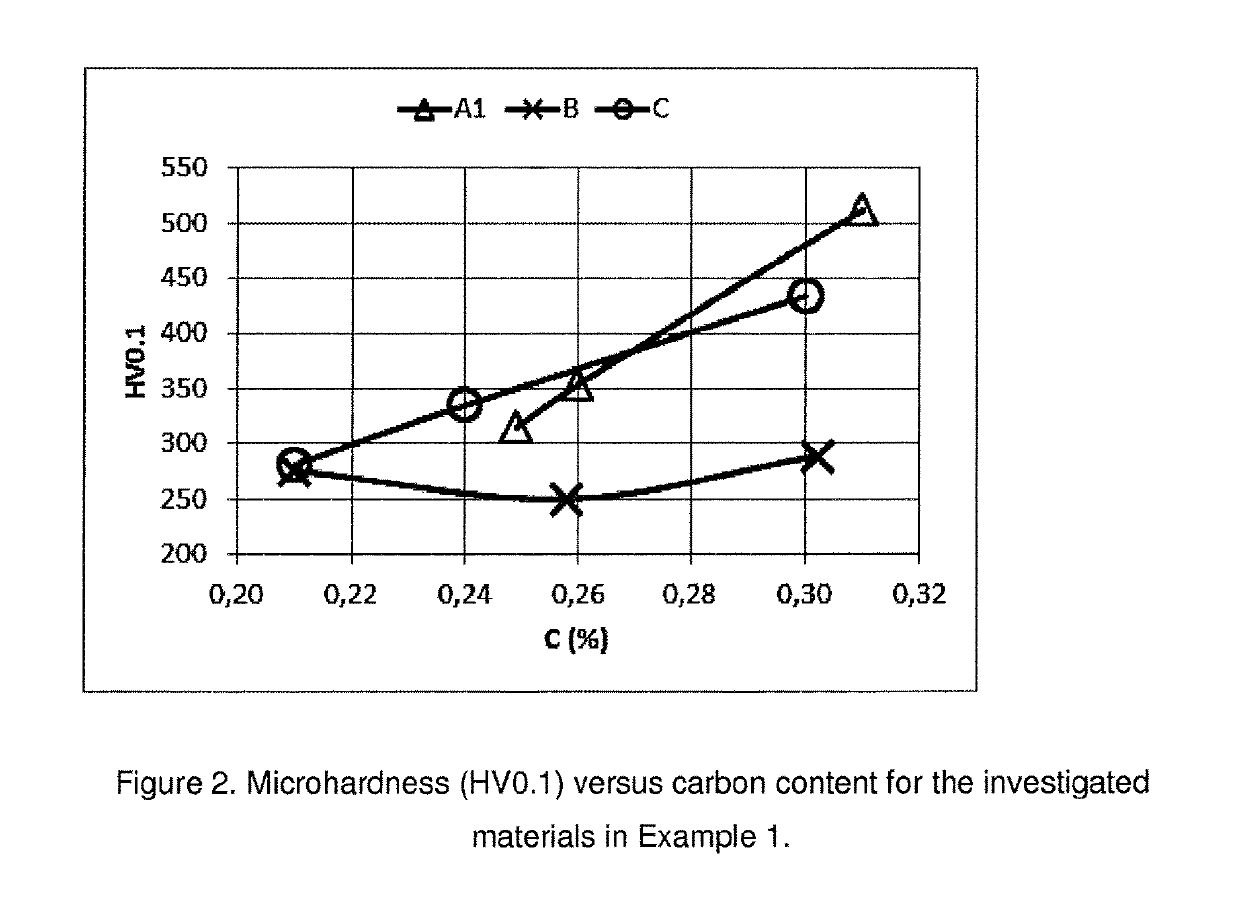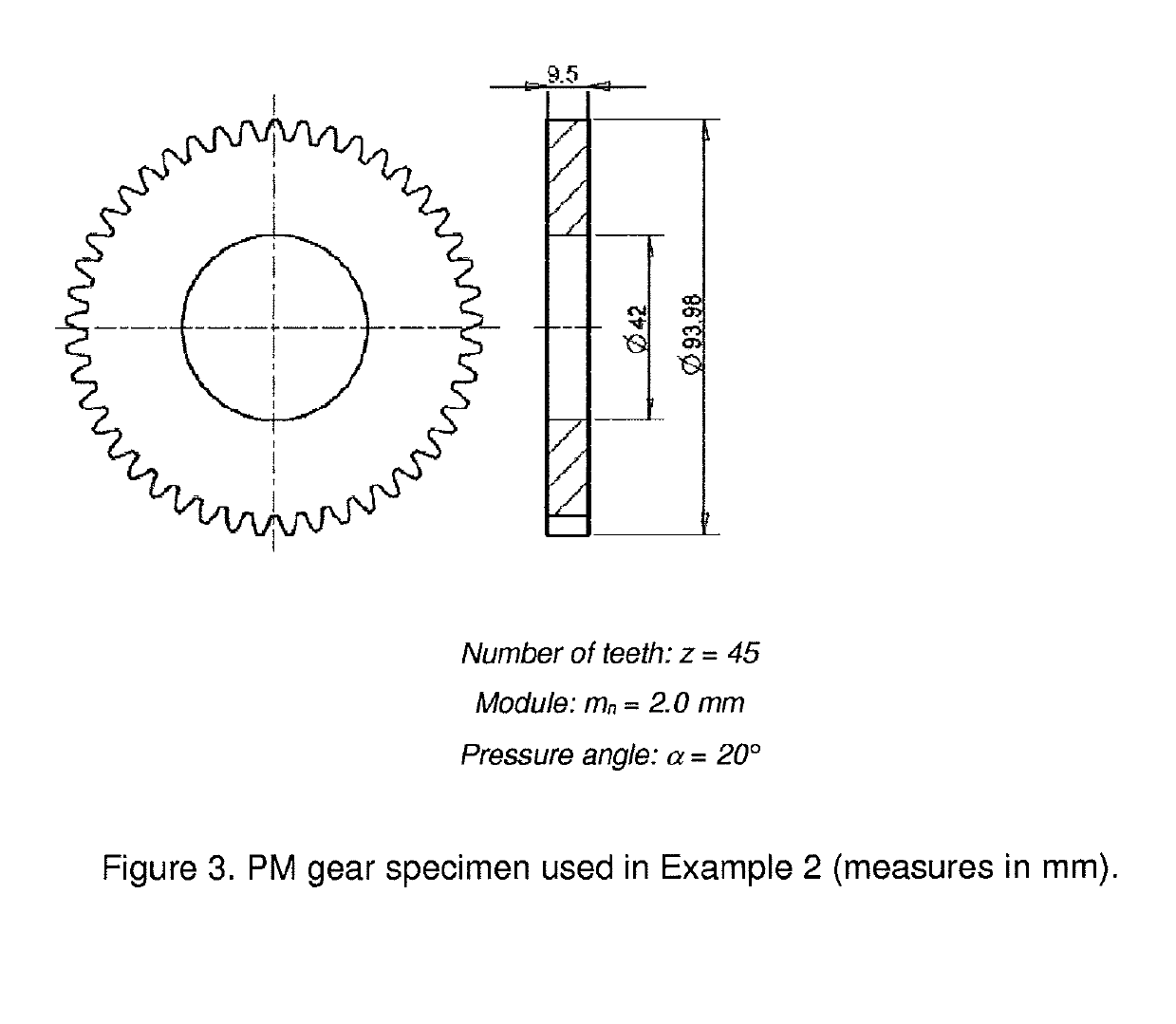Pre-alloyed iron-based powder, an iron-based powder mixture containing the pre-alloyed iron-based powder and a method for making pressed and sintered components from the iron-based powder mixture
a technology of pre-alloyed iron and powder, which is applied in the field of pre-alloyed iron based powder, can solve the problems of affecting the mechanical properties of the part, affecting the attractiveness of the addition of these elements, and exhibiting a certain degree of porosity of the sintered parts
- Summary
- Abstract
- Description
- Claims
- Application Information
AI Technical Summary
Benefits of technology
Problems solved by technology
Method used
Image
Examples
example 1
[0088]A pre-alloyed steel powder according to the invention, A1, was produced by water-atomization followed by a subsequent reduction annealing process. Atomization was done in protective N2 atmosphere in a small-scale (15 kg melt size) water-atomization unit. Annealing was done in a lab-scale belt furnace in H2 atmosphere at a temperature in the range of 1000-1100° C. Milling and sieving (−212 □m) of the powders was done after annealing. The chemical composition of the powder is presented in Table 1 together with the compositions of two other pre-alloyed steel powders which are commercial grades, B=Astaloy® 85Mo and C=Astaloy@CrA, available from Höganäs AB, Sweden, and used as reference materials. All three powders have standard particle size distribution for PM and are sieved with a −212 μm mesh sieve size.
[0089]
TABLE 1Chemical composition (in wt %).PowderFe (%)Cr (%)Mo (%)Mn (%)O (%)C (%)A1Base0.900.340.030.03B Base0.030.850.090.07C Base1.800.040.090.14
[0090]The compressibility o...
example 2
[0096]A pre-alloyed steel powder A2, according to the invention, was produced by water-atomization followed by a subsequent reduction annealing process. Atomization was done in protective N2 atmosphere in a small-scale (15 kg melt size) water-atomization unit. Annealing was done in a lab-scale belt furnace in H2 atmosphere at a temperature in the range of 1000-1100° C. Milling and sieving (−212 □m) of the powders was done after annealing. The chemical composition of the powder is presented in Table 2. The powder has standard particle size distribution for PM and is sieved with a −212 μm mesh sieve size.
[0097]
TABLE 2Chemical composition (in wt %).PowderFe (%)Cr (%)Mo (%)Mn (%)O (%)C (%)A2Base0.850.300.040.06
[0098]Powder A2 was mixed with 0.40 wt % graphite (C-UF) and 0.60 wt % lubricant (Lube E). Large gear specimens (see dimensions in FIG. 3) were compacted from the powder mix by uniaxial compaction with a compaction pressure of 700 MPa. Green density of the gear specimens was 7.20 ...
example 3
[0102]Pre-alloyed steel powders with different contents of Cr (0.5-1.0%) and the same content of Mo (0.3%) were produced by water-atomization followed by a subsequent reduction annealing process. Atomization was done in protective N2 atmosphere in a small-scale (15 kg melt size) water-atomization unit. Annealing was done in a lab-scale belt furnace in H2 atmosphere at a temperature in the range of 1000-1100° C. The same annealing parameters were used for all powders. Milling and sieving (−212□m) of the powders was done after annealing. Chemical composition of the powders is presented in Table 3.
[0103]
TABLE 3Chemical composition (in wt %).PowderFeCr (%)Mo (%)Mn (%)O (%)C (%)X1Base0.570.300.040.11X2Base0.760.320.030.13X3Base0.830.320.040.13X4Base0.920.330.030.12X5Base1.000.320.030.11
[0104]The steel powders were mixed with 0.25 / 0.35 wt % graphite (Kropfmühl UF4) and 0.60 wt % lubricant (Lube E, available from Höganás AB, Sweden). The compressibility of the powder mixes was evaluated by...
PUM
| Property | Measurement | Unit |
|---|---|---|
| pressure | aaaaa | aaaaa |
| temperature | aaaaa | aaaaa |
| temperature | aaaaa | aaaaa |
Abstract
Description
Claims
Application Information
 Login to View More
Login to View More - R&D
- Intellectual Property
- Life Sciences
- Materials
- Tech Scout
- Unparalleled Data Quality
- Higher Quality Content
- 60% Fewer Hallucinations
Browse by: Latest US Patents, China's latest patents, Technical Efficacy Thesaurus, Application Domain, Technology Topic, Popular Technical Reports.
© 2025 PatSnap. All rights reserved.Legal|Privacy policy|Modern Slavery Act Transparency Statement|Sitemap|About US| Contact US: help@patsnap.com



